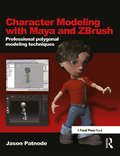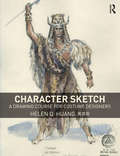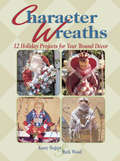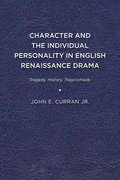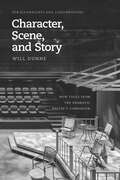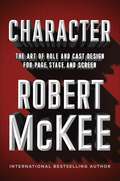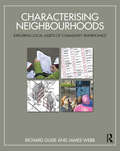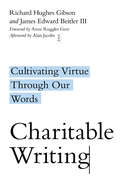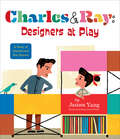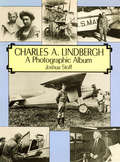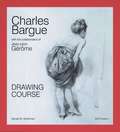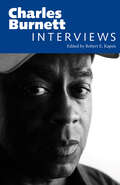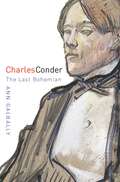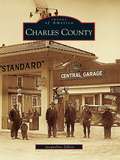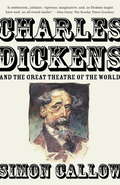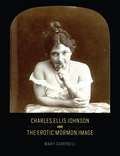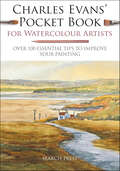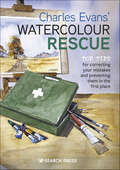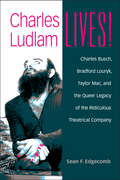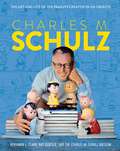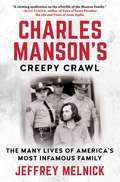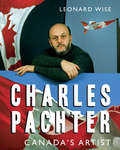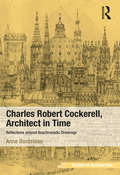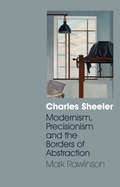- Table View
- List View
Character Modeling with Maya and ZBrush: Professional polygonal modeling techniques
by Jason PatnodeCreate believable CG character models with this unique book and DVD package. The stunning color images show just what you can achieve, and the detailed step-by-step tutorials show exactly how to achieve them. Every technique and tip is backed up with practical tutorials, using the models, textures and video on the companion DVD to offer a crash course to this vital skill. Jason Patnode takes you from low to high-resolution modeling - helping you span the gap between game and film industry skills. Based on Maya 2008 and ZBrush 3.0.You'll learn: Pipeline and modeling guidelines . Overview of Maya . Introduction to ZBrush modeling . Concept art . Anatomy . Creating a video game character . Creating a hyper-real character . Creating a photo-real character . UVs and texturing . How to create a demo reel
Character Sketch: A Drawing Course for Costume Designers
by Helen Q HuangCharacter Sketch outlines a theory of costume rendering that explores how a designer conceptualizes and creates a character on the page. Beginning with how to develop a sense of character through active, gestural poses, this book explores and explains the process of drawing and painting from rough sketch to finished rendering. Helen Q. Huang 黄其智, an award-winning costume designer for more than 25 years, breaks down her process, from understanding body proportions and active poses to applying research and color concepts to renderings. Her step-by-step watercolor painting techniques cover mixing skin tones, blending colors, and applying paint in different methods for a variety of fabric textures and patterns. Showcasing how to capture a character on the page, Character Sketch is a must-read for any costume designer looking to communicate their artistic vision.
Character Wreaths
by Kasey Rogers Mark WoodThe home decor market is going strong - with little sign of slowing - and wreaths are an extremely popular way to add panache to one’s home. This book goes beyond the "typical flower and fruit" wreaths. Readers will find characters that relate to seasons and holidays, including Uncle Sam, Miss Liberty, Santa, a mummy, and Father Time.. Focusing on technique, authors Kasey Rogers and Mark Wood cover the basics of creating a character wreath, from making the face to adding the sleeves to complete the perfect outfit. Each of the projects includes stunning photographs and step-by-step instructions. Detailed instructions for character wreaths that add unique decor to any home. Stunning photographs to guide the reader through each project
Character and the Individual Personality in English Renaissance Drama: Tragedy, History, Tragicomedy (G - Reference, Information And Interdisciplinary Subjects Ser.)
by John E. CurranCharacter and the Individual Personality in English Renaissance Drama: Tragedy, History, Tragicomedy studies instantiations of the individualistic character in drama, Shakespearean and non-Shakespearean, and some of the Renaissance ideas allowing for and informing them. Setting aside such fraught questions as the history of Renaissance subjectivity and individualism on the one hand and Shakespearean exceptionalism on the other, we can find that in some plays, by a range of different authors and collaborators, a conception has been evidenced of who a particular person is, and has been used to drive the action. This evidence can take into account a number of internal and external factors that might differentiate a person, and can do so drawing on the intellectual context in a number of ways. Ideas with potential to emphasize the special over the general in envisioning the person might come from training in dialectic (thesis vs hypothesis) or in rhetoric (ethopoeia), from psychological frameworks (casuistry, humor theory, and their interpenetration), or from historiography (exemplarity). But though they depicted what we would call personality only intermittently, and with assumptions different from our own about personhood, dramatists sometimes made a priority of representing the workings of a specific mind: the patterns of thought and feeling that set a person off as that person and define that person singularly rather than categorically. Some individualistic characters can be shown to emerge where we do not expect, such as with Fletcherian personae like Amintor, Arbaces, and Montaigne of The Honest Man’s Fortune; some are drawn by playwrights often uninterested in character, such as Chapman’s Bussy D’Ambois, Jonson’s Cicero, and Ford’s Perkin Warbeck; and some appear in being constructed differently from others by the same author, as when Webster’s Bosola is set in contrast to Flamineo, and Marlowe’s Faustus is set against Barabas. But Shakespearean characters are also examined for the particular manner in which each troubles the categorical and exhibits a personality: Othello, Good Duke Humphrey, and Marc Antony. Published by University of Delaware Press. Distributed worldwide by Rutgers University Press.
Character, Scene, and Story: New Tools from the Dramatic Writer's Companion (Chicago Guides to Writing, Editing, and Publishing)
by Will DunneWill Dunne first brought the workshop experience down to the desk level with The Dramatic Writer’s Companion, offering practical exercises to help playwrights and screenwriters work through the problems that arise in developing their scripts. Now writers looking to further enhance their storytelling process can turn to Character, Scene, and Story. Featuring forty-two new workshop-tested exercises, this sequel to The Dramatic Writer’s Companion allows writers to dig deeper into their scripts by fleshing out images, exploring characters from an emotional perspective, tapping the power of color and sense memory to trigger ideas, and trying other visceral techniques. The guide also includes a troubleshooting section to help tackle problem scenes. Writers with scripts already in progress will find they can think deeper about their characters and stories. And those who are just beginning to write will find the guidance they need to discover their best starting point. The guide is filled with hundreds of examples, many of which have been developed as both plays and films. Character, Scene, and Story is fully aligned with the new edition of The Dramatic Writer’s Companion, with cross-references between related exercises so that writers have the option to explore a given topic in more depth. While both guides can stand alone, together they give writers more than one hundred tools to develop more vivid characters and craft stronger scripts.
Character: The Art of Role and Cast Design for Page, Stage, and Screen
by Robert MckeeThe long-awaited third volume of Robert McKee&’s trilogy on the art of fiction. Following up his perennially bestselling writers' guide Story and his inspiring exploration of the art of verbal action in Dialogue, the most sought-after expert in the storytelling brings his insights to the creation of compelling characters and the design of their casts. CHARACTER explores the design of a character universe: The dimensionality, complexity and arcing of a protagonist, the invention of orbiting major characters, all encircled by a cast of service and supporting roles.
Characterising Neighbourhoods: Exploring Local Assets of Community Significance
by James Webb Richard GuiseIt is increasingly important to define what constitutes the unique character of our neighbourhoods, in order to identify what we value and should protect, to pinpoint areas for improvement and places which could be enhanced through sensitive change. But how do we define ‘character’ or a ‘sense of place’? How do we appraise the setting and site of a development area, in order that the essential character is retained and reflected in the design of new development? How can these qualities be communicated to decision makers and involve communities? Characterising Neighbourhoods provides an accessible and richly illustrated guide to the practical methods of appraising neighbourhoods which are precise, well informed and engaging. It demonstrates how characterisation is used as an evidence base for the planning and management of neighbourhoods and urban areas. The core focus is on a proven characterisation method developed and used by the authors and used by community groups, schools, planning and urban design students and professionals. It creates a common language used by these groups in evaluating places. This guide provides a wealth of supporting information, including; briefing on the recognition of local architectural styles, periods and materials, detecting the influence of historic street layouts and property boundaries, townscape concepts such as scale and enclosure, and topographical characteristics. Characterising Neighbourhoods is a valuable resource for practicing planners, urban designers and environmental professionals as well as students in these subjects.
Charitable Writing: Cultivating Virtue Through Our Words
by James Edward Beitler III Richard Hughes GibsonOur written words carry weight. Unfortunately, in today's cultural climate, our writing is too often laced with harsh judgments and vitriol rather than careful consideration and generosity. But might the Christian faith transform how we approach the task of writing? How might we love God and our neighbors through our writing? This book is not a style guide that teaches you where to place the comma and how to cite your sources (as important as those things are). Rather, it offers a vision for expressing one's faith through writing and for understanding writing itself as a spiritual practice that cultivates virtue. Under the guidance of two experienced Christian writers who draw on authors and artists throughout the church's history, we learn how we might embrace writing as an act of discipleship for today—and how we might faithfully bear the weight of our written words.
Charles & Ray: A Story of Charles and Ray Eames
by James YangA playful introduction to the designs of Charles and Ray Eames by Geisel-winning creator James Yang.Charles was an architect. Ray was a painter. Together they made the perfect team. By using structure, shape, and color, they knew they could transform anything. And because they saw problem-solving as an adventure, they were able to incorporate playfulness into everything they designed.Geisel Award-winning author and illustrator James Yang has created an exuberant story about Charles and Ray Eames, two of the most iconic designers of the Mid-century modern design movement, which will inspire readers to dream up new ways to see the world around them.
Charles A. Lindbergh: The Life of the "Lone Eagle" in Photographs (Dover Transportation)
by Joshua StoffExtensive pictorial anthology chronicles extraordinary career of the man who changed aviation history. Over 250 rare photographs, accompanied by detailed captions depict Lindbergh in childhood photos, shots of his "barnstorming" days, views of the young pilot examining damage to his Curtiss JN-4 "Jenny" after crashing in 1923, and touring with the Spirit of St. Louis.
Charles Bargue: Drawing Course
by Gerald Ackerman Graydon ParrishThe Bargue-Gerome Drawing Course is a complete reprint of a famous, late nineteenth century drawing course. It contains a set of almost two hundred masterful lithographs of subjects for copying by drawing students before they attempt drawing from life or nature. Consequently it is a book that will interest artists, art students, art historians, and lovers and collectors of drawings. It also introduces us to the work and life of a hitherto neglected master: Charles Bargue. <P> The Drawing Course consists of three sections. The first consists of plates drawn after casts, usually of antique examples. Different parts of the body are studied in order of difficulty, until full figures are presented. The second section pays homage to the western school of painting with lithographs after exemplary drawings by Renaissance and modern masters. The third part contains almost sixty academies or drawings after nude male models, all original inventions by Bargue, the lithographer. With great care, the student is introduced to continually more difficult problems in the close observing and recording of nature. <P> Practiced professional artists will see at once the problems of representation that are approached by Bargue, and they will delight in his solutions. Figure painters will copy the plates to keep in tune; so to speak, much as pianists practice the exercises of Czerny before performing Beethoven. Art students will find it a practical and progressive introduction to realistic figure drawing. Art historians can learn by studying these drawings just what was prized in late 19th century figure painting. They will recognize the reliance upon tradition by the use of antique sculptures as models in the first part: Antiquity is here used, not to impose a classical style, but as an aid in seeing the structure of the human body with clarity and intelligence. The result is a convergence of Classicism and Realism. <P> There are no numerical proportional charts, perspective boxes or geometrical schemata to memorize. All the techniques and schemata are developed out of and for the object or person in view. The drawings are splendid; beautiful; not simply products of assiduity, but of careful observation and the wish to transcribe and communicate the beauty of nature and light, as well as the manifold appearances of the human body. These are objectives that will touch and move any careful reader of drawings, and the figurative arts. Charles Bargue started his career as a lithographer of drawings by hack artists for a popular market in comic, sentimental and soft-porn subjects. By working with Gerome, and in preparing the plates for the course, Bargue was transformed into a spectacular painter of single figures and intimate scenes; a master of precious details that always remain observation and never became self-conscious virtuosity, of color schemes that unified his composition in exquisite tonal harmonies. The last part of the book is a biography of Bargue, along with a preliminary catalogue of his paintings, accompanied by reproductions of all that have been found and of many of those lost.
Charles Burnett: Interviews (Conversations with Filmmakers Series)
by Robert E. KapsisCharles Burnett (b. 1944) is a groundbreaking African American filmmaker and one of this country’s finest directors, yet he remains largely unknown. His films, most notably Killer of Sheep (1977) and To Sleep with Anger (1990), are considered classics, yet few filmgoers have seen them or heard of Burnett. The interviews in this volume explore this paradox and collectively shed light on the work of a rare film master whose stories bring to the screen the texture and poetry of life in the black community.The best qualities of Burnett’s films-rich characterizations, morally and emotionally complex narratives, and intricately observed tales of African American life-are precisely the things that make his films a tough sell in the mass marketplace. As many of the interviews reveal, Hollywood has been largely inept in responding to this marketing challenge. “It takes an extraordinary effort to keep going,” Burnett told Terrence Rafferty in 2001, “when everybody’s saying to you, ‘No one wants to see that kind of movie,’ or ‘There’s no black audience.’” All the interviews selected for this volume—spanning more than three decades of Burnett’s directorial career, including his recent work—examine, in various degrees, Burnett’s status as a true independent filmmaker and explore his motivation for making films that chronicle the black experience in America.
Charles Conder: The Last Bohemian
by Ann GalballyCharles Conder was one of the youngest, most original and most talented members of the Heidelberg School of impressionist painters, and one of the few to achieve a lasting reputation outside Australia. His work hangs in many major collections, including the Tate Britain, the Victoria and Albert Museum and the National Portrait Gallery in London and the Metropolitan Museum in New York. Paris beckoned early, and he soon fell in with the fin de si�cle generation led by Oscar Wilde, Henri de Toulouse-Lautrec and Aubrey Beardsley. He embraced Bohemia, was forever in debt, worked erratically but unceasingly and lived as if there were no tomorrow. Conder was rescued from poverty by marriage to a wealthy Canadian widow, but his bohemian past eventually called in its account. Tragically, he descended into syphilitic madness and died in his fortieth year. Conder's was a beguiling, charmed, desperate life. He was handsome, rakish, sociable and extraordinarily talented. Anne Galbally's splendid biography is as passionate and fascinating as her subject.
Charles County
by Jacqueline ZillioxFaithful subjects of the English crown, Jesuits, and entrepreneurs first settled in Charles County in the early 1630s. The area quickly sprouted into Colonial-styled plantation life of distinct Southern charm. The currency of the day was tobacco, even for payment of taxes and doctor bills. Through the War of 1812 and the Civil War, the mainly agricultural economy of the county was devastated. But as time passed, plantations became farmsteads, Native American trails became roadways, and the railroad created new town centers, such as Waldorf and La Plata. In the earlier years, the county's self-sufficiency was strongly displayed when the public school system and fire departments were started through private donations. For most of its life, Charles County's only employer not associated with agriculture was the Indian Head Naval Proving Ground, now known as the Indian Head Division, Naval Surface Warfare Center. It is still ranked as the county's number one employer. Tobacco still reigned as the cash crop of choice until 2000.
Charles Dickens and the Great Theatre of the World
by Simon CallowAcclaimed actor and writer Simon Callow offers a fresh perspective on one of the greatest novelists in the English language, Charles Dickens, in this lively, colorful biography. Dickens was one of the first true celebrity authors. Thousands of fans in Britain and America eagerly awaited each new installment of his stories and flocked to see him on his legendary speaking tours. Not only did he create an incredible cast of characters on the page, but he was also a dazzling mimic and storyteller, and he wrote, stage-managed, and acted in plays for the public. Throughout his life, from his childhood performances in pubs to his legendarily powerful reading tours, Dickens was fanatical about the stage. Callow reveals Dickens's genius on and off the page and offers a compelling insight into a life that was driven as much by performance and showmanship as by literature.
Charles Ellis Johnson and the Erotic Mormon Image
by Mary CampbellOn September 25, 1890, the Mormon prophet Wilford Woodruff publicly instructed his followers to abandon polygamy. In doing so, he initiated a process that would fundamentally alter the Latter-day Saints and their faith. Trading the most integral elements of their belief system for national acceptance, the Mormons recreated themselves as model Americans. Mary Campbell tells the story of this remarkable religious transformation in Charles Ellis Johnson and the Erotic Mormon Image. One of the church's favorite photographers, Johnson (1857-1926) spent the 1890s and early 1900s taking pictures of Mormonism's most revered figures and sacred sites. At the same time, he did a brisk business in mail-order erotica, creating and selling stereoviews that he referred to as his "spicy pictures of girls." Situating these images within the religious, artistic, and legal culture of turn-of-the-century America, Campbell reveals the unexpected ways in which they worked to bring the Saints into the nation's mainstream after the scandal of polygamy. Engaging, interdisciplinary, and deeply researched, Charles Ellis Johnson and the Erotic Mormon Image demonstrates the profound role pictures played in the creation of both the modern Church of Jesus Christ of Latter-day Saints and the modern American nation.
Charles Evans’ Pocket Book for Watercolour Artists: Over 100 Essential Tips to Improve Your Painting
by Charles EvansA new pocket-book edition of the bestselling watercolour tip book by renowned artist Charles Evans.Discover 100 top tips for painting in watercolour that will take the mystery out of painting, covering topics from creating depth, introducing harmony, how to deal with light and shade and how to create mood and atmosphere, this book was previously published as Charlie's Top Tips for Watercolour Artists.Contained inside one slim, notebook-size book that will fit perfectly in your kit bag for easy transportation while painting on the go, it includes quick, clever tips that are easy to follow and effective.
Charles Evans’ Watercolour Rescue: Top Tips for Correcting Your Mistakes and Preventing Them in the First Place
by Charles EvansWatercolour is a difficult medium to master, and even experienced artists are prone to making mistakes.Over the years he has spent working as a professional artist and demonstrator, Charles Evans has built up a huge bank of expert advice, tricks, tips and techniques for fixing common watercolour problems, correcting mistakes, and learning how to avoid them in the first place. These problems include how to remove ‘cauliflowers’, avoiding or fixing water spillages, preventing colours from bleeding into one another, making distant hills look, well, distant, and making less muddy colour mixes.Each problem is one that Charles is commonly asked to solve, (such as My trees look like lollipops), followed by Charles' solution, and a short demonstration of how to prevent the problem occurring next time you paint.
Charles Ludlam Lives!: Charles Busch, Bradford Louryk, Taylor Mac, and the Queer Legacy of the Ridiculous Theatrical Company
by Sean EdgecombPlaywright, actor and director Charles Ludlam (1943–1987) helped to galvanize the Ridiculous style of theater in New York City starting in the 1960s. Decades after his death, his place in the chronicle of American theater has remained constant, but his influence has changed. Although his Ridiculous Theatrical Company shut its doors, the Ludlamesque Ridiculous has continued to thrive and remain a groundbreaking genre, maintaining its relevance and potency by metamorphosing along with changes in the LGBTQ community. Author Sean F. Edgecomb focuses on the neo-Ridiculous artists Charles Busch, Bradford Louryk, and Taylor Mac to trace the connections between Ludlam’s legacy and their performances, using alternative queer models such as kinetic kinship, lateral historiography, and a new approach to camp. Charles Ludlam Lives! demonstrates that the queer legacy of Ludlam is one of distinct transformation—one where artists can reject faithful interpretations in order to move in new interpretive directions.
Charles M. Schulz: The Creator of PEANUTS in 100 Objects
by Nat Gertler The Charles M. Schulz Museum Benjamin L. ClarkCharles M. Schulz: The Life and Art of the Creator of Peanuts in 100 Objects explores the man behind one of America&’s most iconic comic strips and its beloved cast of characters—Charlie Brown, Snoopy, and the rest of the Peanuts Gang. Through 100 preserved and cataloged artifacts, delve into Charles M. Schulz&’s Minnesota youth in 1920s America, Schulz&’s WWII Army service, and Schulz&’s path to fame through his post-war comic series Li&’l Folks and five decades of Peanuts. From Schulz&’s first published drawing featured in Ripley&’s Believe It or Not! to his 2001 Congressional Gold Medal, the 100 artifacts bring the details of the singular artist to life. Along with provocative, witty, and wise quotes, fan-favorite strips, and more, this book is a must-have for any Peanuts fan. 100 OBJECTS: Carefully curated artifacts from Charles M. Schulz&’s home and studio—including medals and awards, family photos, rare comic art, and more—tell the story of this beloved artist&’s life, career, and the times in which he lived. EXPLORE AMERICANA: From his youth in 1920&’s Minnesota through the turbulent 60s and beyond, Charles Schulz&’s life spans the rich history of the American Century. CLASSIC STRIPS: Includes timeless Peanuts comic strips featuring Charlie Brown, Snoopy, and the whole Peanuts Gang. FASCINATING FACTS: Fans of Peanuts will find never-before-seen items that give them an intimate look at the creation of the acclaimed comic strip series. OFFICIAL ACCOUNT: Created in collaboration with the Charles M. Schulz estate, the book provides an exclusive look into the life of one of America&’s most revered artists.
Charles Manson's Creepy Crawl: The Many Lives of America's Most Infamous Family
by Jeffrey MelnickWith a new epilogue updated from its hardcover edition titled Creepy Crawling: Charles Manson and the Many Lives of America's Most Infamous Family "Creepy crawling" was the Manson Family's practice of secretly entering someone's home, and without harming anyone, leaving only a trace of evidence that they had been there, some reminder that the sanctity of the private home had been breached. Now, author Jeffrey Melnick reveals just how much the Family creepy crawled their way through Los Angeles in the sixties and then on through American social, political, and cultural life for fifty years, firmly lodging themselves in our minds. Even now, it is almost impossible to discuss the sixties, teenage runaways, sexuality, drugs, music, California, or even the concept of family without referencing Manson and his "girls." Not just another Charles Manson history, Charles Manson's Creepy Crawl: The Many Lives of America's Most Infamous Family explores how the Family weren't so much outsiders as emblematic of the Los Angeles counterculture freak scene, and how Manson worked to connect himself to the mainstream of the time. Ever since they spent two nights killing seven residents of Los Angeles—what we now know as the "Tate-LaBianca murders"—the Manson family has rarely slipped from the American radar for long. From Emma Cline's The Girls to the TV show Aquarius, as well as two major films in 2019, including Quentin Tarantino's Once Upon a Time in Hollywood, the family continues to find an audience. What is it about Charles Manson and his family that captivates us still? Author Jeffrey Melnick sets out to answer this question in this fascinating and compulsively readable cultural history of the Family and their influence from 1969 to the present.
Charles Pachter: Canada's Artist
by Margaret Atwood Tom Smart Leonard WiseAn Officer of the Order of Canada, Chevalier of France’s Order of Arts and Letters, and recipient of the Order of Ontario, painter, printmaker, sculptor, designer, and author, Charles Pachter is one of Canada’s best-loved and most celebrated artists. Pachter is an artist with an astonishing range. His work is witty, thoughtful, moving, and personal. Many works, like Queen on Moose, The Painted Flag, and Hockey Knights in Canada, have achieved a remarkable level of recognition, becoming famous across the country — indeed, around the world. His collaboration with Margaret Atwood on The Journals of Susanna Moodie has been called “truly the most magnificent book ever to be published in Canada.” Charles Pachter: Canada’s Artist is a celebration of the life and work — the struggles and triumphs — of a man who has helped to redefine Canadian art. Pachter’ promotion of Canada and its culture has left a lasting legacy — one that he continues to build on.
Charles Robert Cockerell, Architect in Time: Reflections around Anachronistic Drawings
by Anne BordeleauSpeed, acceleration and rapid change characterize our world, and as we design and construct buildings that are to last at least a few decades and sometimes even centuries, how can architecture continue to act as an important cultural signifier? Focusing on how an important nineteenth-century architect addressed the already shifting relation between architecture, time and history, this book offers insights on issues still relevant today-the struggle between imitation and innovation, the definition (or rejection) of aesthetic experience, the grounds of architectural judgment (who decides and how), or fundamentally, how to act (i.e. build) when there is no longer a single grand narrative but a plurality of possible histories. Six drawings provide the foundation of an itinerary through Charles Robert Cockerell’s conception of architecture, and into the depths of drawings and buildings. Born in England in 1788, Cockerell sketched as a Grand Tourist, he charted architectural history as Royal Academy Professor, he drew to build, to exhibit, to understand the past and to learn from it, publishing his last work in 1860, three years before his death. Under our scrutiny, his drawings become thresholds into the nineteenth century, windows into the architect’s conception of architecture and time, complex documents of past and projected constructions, great examples that reveal a kinetic approach to ornamentation, and the depth of architectural representation.
Charles Sheeler: Modernism, Precisionism and the Borders of Abstraction
by Mark RawlinsonCharles Sheeler was the stark poet of the machine age. Photographer of the Ford Motor Company and founder of the painting movement Precisionism, he is remembered as a promoter of - and apologist for - the industrialised capitalist ethic. This major new rethink of one of the key figures of American modernism argues that Sheeler's true relationship to progress was in fact highly negative, his 'precisionism' both skewed and imprecise. Covering the entire oeuvre from photography to painting and drawing attention to the inconsistencies, curiosities and 'puzzles' embedded in Sheeler's work, Rawlinson reveals a profound critique of the processes of rationalisation and the conditions of modernity. The book argues finally for a re-evaluation of Sheeler's often dismissed late work which, it suggests, may only be understood through a radical shift in our understanding of the work of this prominent figure.
